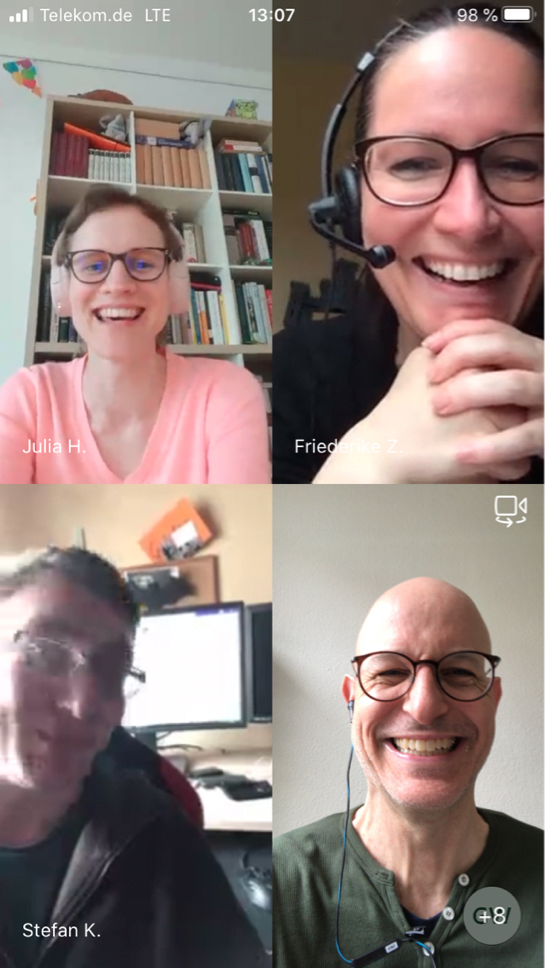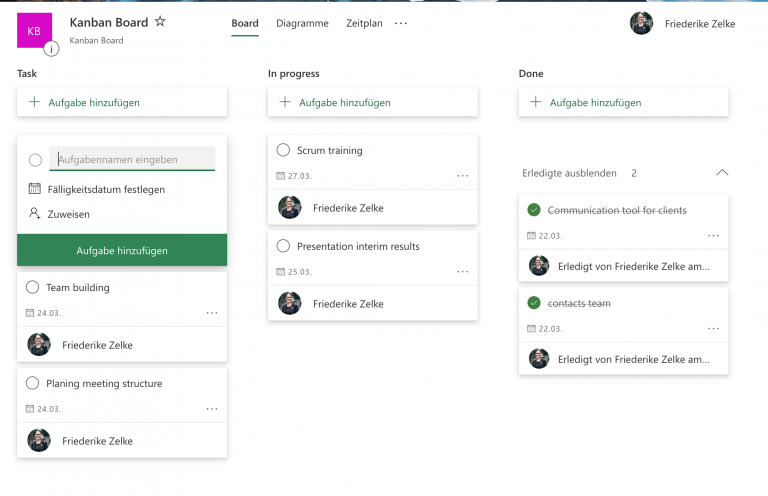Tips for remote teams
Nowadays, project managers are almost used to the fact that the colleagues implementing the project are not always on site, but work at home, at an external customer or even in different countries. Nevertheless, it is always a great challenge to really create an environment in which each person is perceived as part of the team, to introduce transparent communication and to establish good cooperation
For teams that are only just switching to home and digital project work, this is a major challenge that needs to be carefully monitored by the project manager.

Agile methods and tools
There are various methods and tools that can and should be used for project management. Basically, agile project work has proven to be a target-oriented approach in recent years. Four central aspects are understood by agility: Speed, adaptability, customer focus and attitude. Speed and adaptability are understood to mean that organizations or, in our case, project teams react quickly and dynamically to changes or other results than expected and are able to adapt quickly, i.e. find new approaches to solutions quickly. The third aspect is the stronger customer focus that is achieved through agility. This refers primarily to the short cycles and iterations, the ability to move forward in small steps and to react quickly and selectively to customer requirements. Agile attitude, sometimes also called agile mindset, encompasses various points regarding interpersonal behaviour. Essential here is an appreciative way of dealing with others, which enables an encounter at eye level, and open, goal-oriented communication.
In order to work agile within a project, there are methods and tools like Scrum and Kanban boards, e.g. Trello, Jira, Microsoft Planner and many more. Scrum was designed as a project management method for software development, but is now used for all kinds of projects. The starting point was and is that many projects are too complex to be captured in a complete, all-inclusive plan. An essential part of the requirements and the solution approaches are unclear at the beginning. This ambiguity can be eliminated by defining intermediate results. Based on these intermediate results, the missing requirements and solution techniques can be found more efficiently than through comprehensive project planning. In Scrum planning is developed iteratively and based on each other. The long-term plan is continuously refined and improved. The detailed plan is only created for the next cycle (the sprint). This allows the project planning to focus on the essentials. Three points are crucial in Scrum:
- Transparency: Progress and obstacles of a project are recorded regularly and visible for all.
- Review: Project results are regularly delivered and evaluated.
- Adaptation: Requirements for the product, plans and procedures are not fixed once and for all, but continuously and in detail adapted. Scrum does not reduce the complexity of the overall task, but structures it into smaller and less complex components
Tools such as Kanban boards support the Scrum method and ensure transparent clarity and clear allocation of tasks. Kanban boards also come from software development, but are also used across project management. The first step in introducing Kanban is to visualize the existing processes, the existing work and problems. This is done in the form of a Kanban board. The individual sprints are divided into individual tasks. These are entered into the board as notes, a table in which the status of each individual task can be seen at first glance. Table columns are e.g. tasks / in process / completed (simple example is shown on figure 1). If it becomes apparent while editing the tasks that even this planning was too vague, new single tasks can be defined very quickly. It has proved to be useful to assign the individual tasks to only one team member at a time, who is then responsible for completion. This way, the project manager always has a quick overview of where the team currently stands, where there are problems and whether the sprint can be completed in the defined time. The team members can see at a glance what they are responsible for in the near future. This does not mean that they are left alone with their tasks, because they work in a team, but still bear this responsibility. Proper communication is crucial for team cooperation.

Team communication
Especially when working remotely, the exchange of ideas must be possible within the team, the different team members must be able to communicate with each other. If the technical prerequisites are in place (see the white paper on digital work, https://cloudical.io/white-paper/), the most important thing is to set up regular meetings to keep everyone on the same page – daily, or at least weekly meetings have proven effective here.
Regular exchange is especially important when the team cannot meet in person. In this case, the social factor must also be taken into account in the daily exchange. Meetings should be short and focused, the project status should be recorded and a plan for the day should be produced. At least once a week, the project manager should also allow time for chatting, which is essential for the team feeling. If the meeting takes place in the morning, it can start, for example, with each participant holding his/her coffee cup to the camera and telling how the week is going apart from the project. This has the charming side effect that the cameras must be turned on during the meeting. This is also an important factor in being able to see your team members, see non-verbal reactions and thus have a greater interpersonal component in the meeting (figure 2). These social meetings should also be time-limited, but should be sized to allow members to joke or complain. When teams work exclusively remotely, the project leader must be sensitive to the mood of the team; there may be a greater need for social exchange than once a week. Nevertheless, not all meetings should degenerate into chat sessions, so that a good, productive balance is found.
It is important in these meetings that each participant has his or her say and can give feedback. Everyone should be given about the same amount of speaking time so that the quieter team members can participate in the exchange and the more eloquent ones get a framework.
If the Scrum method is used for project work, the respective sprints should be discussed in the team. The tasks for the next period are placed in the context of the overall project and briefly discussed individually so that each team member is aware of what he or she is responsible for in the sprint. It has proven to be a good idea for each team member to repeat their tasks in their own words, this way it shows that they have really been understood. The status of the tasks is clarified in the daily meetings, difficulties are discussed and, if possible, a solution is worked out so that the sprint produces the desired results.
Other factors that need to be considered when communicating in a widespread international team are time differences, cultural backgrounds and language barriers. Meetings should be held at an acceptable time for everyone in the team. Especially in international teams, the time difference must be taken into account: If it is late in the morning in Germany, the colleagues in India, for example, are already at work, while for the US team members the working day has not even started yet. Appointment scheduling tools such as Calendly or FindTime take into account the time zones of all participants. It must also be kept in mind that when the sender’s workday has just begun and the recipient is already at work, some urgent messages may take longer to respond. For emergencies that cannot be postponed, appropriate substitution arrangements should therefore be made.
Different cultural backgrounds and also language barriers require different types of communication, the effects of which often only come to bear when the project is already well advanced. Here too, the project manager has the important task of ensuring that a lack of social component or even a lack of cultural understanding between the people in the project, who only know each other through the various means of communication, can appear like fine sand in the gears and ultimately condemn the project to failure. To avoid misunderstandings and problems, clear expectations should be communicated by all participants: Tasks, goals, deadlines and progress within the project should be recorded in writing by everyone. In addition, open communication should be made possible, in which misunderstandings, problems and difficulties in understanding can and should be addressed openly in order to find common solutions and make joint work possible at all.
Conclusion
Remote project teams are a challenge for project managers, which can be mastered with a clear project structure, the right tools and balanced, open communication within the team.
Links
Agility
https://the-report.cloud/agile-transformation-for-small-and-medium-sized-enterprises-first-steps
https://the-report.cloud/agility-in-the-cloud
https://en.wikipedia.org/wiki/Agile_software_development
Kanban
https://medium.com/re-write/managing-projects-easier-with-a-kanban-board-30a988a99f57
https://en.wikipedia.org/wiki/Kanban
Scrum
https://en.wikipedia.org/wiki/Scrum_(software_development)

Author:
Friederike Zelke
Editor in Chief
Friederike.zelke@cloudical.io
